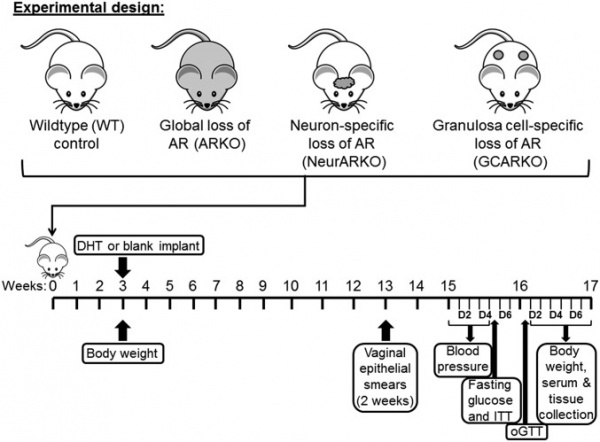File:Kirsty Walters.jpg: Difference between revisions
mNo edit summary |
mNo edit summary |
||
| Line 8: | Line 8: | ||
:'''Links:''' [https://research.unsw.edu.au/people/dr-kirsty-walters UNSW Researcher] | [[ANAT2341 Lab 6|ANAT2341 Lab]] | {{PCOS}} | :'''Links:''' [https://research.unsw.edu.au/people/dr-kirsty-walters UNSW Researcher] | [[ANAT2341 Lab 6|ANAT2341 Lab]] | {{PCOS}} | ||
==An Introduction to Polycystic Ovary Syndrome (PCOS)== | |||
<html5media width="600" height="400">https://www.youtube.com/embed/NhyYZCBq5A8</html5media> | |||
==Polycystic Ovary Syndrome Mouse Model== | |||
{{#pmid:28320971}} | |||
{| | |||
| [[File:Polycystic ovary syndrome mouse model.jpg|600px]] | |||
| '''Experimental design''' | |||
<br> | |||
For this study, PCOS was induced in wild-type, global, neuron-specific, and granulosa cell-specific androgen receptor knockout mice by s.c. inserting dihydrotestosterone implants in the mice for 3 mo. Control mice were implanted with blank implants. | |||
<br><br> | |||
Body weight, estrous cycling, blood pressure, fasting glucose, oral glucose tolerance, and insulin tolerance were assessed before collection of serum and tissues at 16 wk of age. | |||
<br><br> | |||
[[File:Dihydrotestosterone.jpg|thumb|150px|link=Genital - Male Development|alt=Dihydrotestosterone structure cartoon|link=Genital - Male Development|Dihydrotestosterone]] | |||
'''Dihydrotestosterone''' - The hormonally active form of testosterone (male sex hormone) produced by enzyme (5-alpha reductase) conversion. In the male embryo, this can occur in the genital skin which then supports external genital development. In the adult, this conversion occurs in a number of different tissues. A known treatment for prostate cancer include 5-alpha reductase inhibitors. | |||
|} | |||
==Role of Androgens in the Ovary== | |||
{{#pmid:28687450}} | |||
:"It has been well established for decades that androgens, namely {{testosterone}} (T) plays an important role in female reproductive physiology as the precursor for oestradiol (E2). However, in the last decade a direct role for androgens, acting via the androgen receptor (AR), in female reproductive function has been confirmed. Deciphering the specific roles of androgens in ovarian function has been hindered as complete androgen resistant females cannot be generated by natural breeding. In addition, androgens can be converted into estrogens which has caused confusion when interpreting findings from pharmacological studies, as observed effects could have been mediated via the AR or estrogen receptor. The creation and analysis of genetic {{mouse}} models with global and cell-specific disruption of the Ar gene, the sole mediator of pure androgenic action, has now allowed the elucidation of a role for AR-mediated androgen actions in the regulation of normal and pathological ovarian function. This review aims to summarize findings from clinical, animal, pharmacological and novel genetic AR mouse models to provide an understanding of the important roles androgens play in the {{ovary}}, as well as providing insights into the human implications of these roles." | |||
===References=== | ===References=== | ||
Revision as of 10:39, 16 July 2019
Dr Kirsty Walters
Dr Kirsty Walters is a Senior Lecturer in Women’s and Children’s Health at the University of New South Wales (UNSW), Sydney, specialising in the field of female reproduction and ovarian function.
- Links: UNSW Researcher | ANAT2341 Lab | PCOS
An Introduction to Polycystic Ovary Syndrome (PCOS)
<html5media width="600" height="400">https://www.youtube.com/embed/NhyYZCBq5A8</html5media>
Polycystic Ovary Syndrome Mouse Model
Caldwell ASL, Edwards MC, Desai R, Jimenez M, Gilchrist RB, Handelsman DJ & Walters KA. (2017). Neuroendocrine androgen action is a key extraovarian mediator in the development of polycystic ovary syndrome. Proc. Natl. Acad. Sci. U.S.A. , 114, E3334-E3343. PMID: 28320971 DOI.
Role of Androgens in the Ovary
Walters KA & Handelsman DJ. (2017). Role of androgens in the ovary. Mol. Cell. Endocrinol. , , . PMID: 28687450 DOI.
- "It has been well established for decades that androgens, namely testosterone (T) plays an important role in female reproductive physiology as the precursor for oestradiol (E2). However, in the last decade a direct role for androgens, acting via the androgen receptor (AR), in female reproductive function has been confirmed. Deciphering the specific roles of androgens in ovarian function has been hindered as complete androgen resistant females cannot be generated by natural breeding. In addition, androgens can be converted into estrogens which has caused confusion when interpreting findings from pharmacological studies, as observed effects could have been mediated via the AR or estrogen receptor. The creation and analysis of genetic mouse models with global and cell-specific disruption of the Ar gene, the sole mediator of pure androgenic action, has now allowed the elucidation of a role for AR-mediated androgen actions in the regulation of normal and pathological ovarian function. This review aims to summarize findings from clinical, animal, pharmacological and novel genetic AR mouse models to provide an understanding of the important roles androgens play in the ovary, as well as providing insights into the human implications of these roles."
References
Walters KA, Rodriguez Paris V, Aflatounian A & Handelsman DJ. (2019). Androgens and ovarian function: translation from basic discovery research to clinical impact. J. Endocrinol. , , . PMID: 31125975 DOI.
Stepto NK, Moreno-Asso A, McIlvenna LC, Walters KA & Rodgers RJ. (2019). Molecular Mechanisms of Insulin Resistance in Polycystic Ovary Syndrome. Unraveling the Conundrum in Skeletal Muscle?. J. Clin. Endocrinol. Metab. , , . PMID: 30938770 DOI.
Walters KA, Edwards MC, Tesic D, Caldwell ASL, Jimenez M, Smith JT & Handelsman DJ. (2018). The Role of Central Androgen Receptor Actions in Regulating the Hypothalamic-Pituitary-Ovarian Axis. Neuroendocrinology , 106, 389-400. PMID: 29635226 DOI.
Leloup-Hatey J, Baloche S & Jolivet-Jaudet G. (1988). [Changes in corticosterone and aldosterone concentrations in various tissues of Xenopus laevis tadpoles during the metamorphosis]. C. R. Seances Soc. Biol. Fil. , 182, 354-60. PMID: 2977958 1
Bertoldo MJ, Walters KA, Ledger WL, Gilchrist RB, Mermillod P & Locatelli Y. (2018). In-vitro regulation of primordial follicle activation: challenges for fertility preservation strategies. Reprod. Biomed. Online , , . PMID: 29503209 DOI.
Upton DH, Walters KA, McTavish KJ, Holt J, Handelsman DJ & Allan CM. (2018). Reproductive failure in mice expressing transgenic follicle-stimulating hormone is not caused by loss of oocyte quality. Biol. Reprod. , 98, 491-500. PMID: 29365049 DOI.
Walters KA & Handelsman DJ. (2017). Role of androgens in the ovary. Mol. Cell. Endocrinol. , , . PMID: 28687450 DOI.
Search PubMed: Walters KA
Cite this page: Hill, M.A. (2024, April 27) Embryology Kirsty Walters.jpg. Retrieved from https://embryology.med.unsw.edu.au/embryology/index.php/File:Kirsty_Walters.jpg
- © Dr Mark Hill 2024, UNSW Embryology ISBN: 978 0 7334 2609 4 - UNSW CRICOS Provider Code No. 00098G
File history
Click on a date/time to view the file as it appeared at that time.
| Date/Time | Thumbnail | Dimensions | User | Comment | |
|---|---|---|---|---|---|
| current | 15:02, 19 July 2018 |  | 170 × 183 (37 KB) | Z8600021 (talk | contribs) | ==Dr Kirsty Walters== Dr Kirsty Walters is a Senior Lecturer in Women’s and Children’s Health at the University of New South Wales (UNSW), Sydney, specialising in the field of female reproduction and ovarian function. :'''Links:''' [https://re... |
You cannot overwrite this file.
File usage
The following 2 pages use this file:

